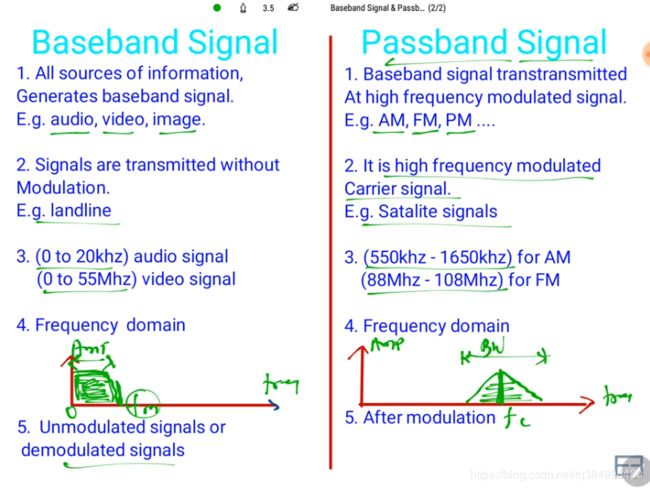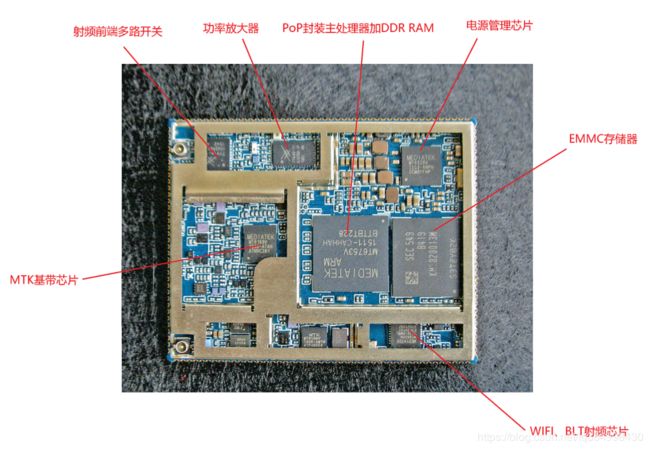【电子】Baseband Signal and Passband Signal
Baseband的参考文章:https://techterms.com/definition/baseband 引用原文:
Baseband refers to the original frequency range of a transmission signal before it is converted, or modulated, to a different frequency range. For example, an audio signal may have a baseband range from 20 to 20,000 hertz. When it is transmitted on a radio frequency (RF), it is modulated to a much higher, inaudible, frequency range.
Signal modulation is used for radio broadcasts, as well as several types of telecommunications, including cell phone conversations and satellite transmissions. Therefore, most telecommunication protocols require original baseband signals to be modulated to a higher frequency before they are transmitted. These signals are then demodulated at the destination, so the recipient receives the original baseband signal. Dial-up modems are a good example of this process, since they modulate and demodulate signals when they are transmitted and received. In fact, the word "modem" is short for modulator/demodulator.
While most protocols require the modulation of baseband signals, some can transmit in baseband without any signal conversion. A common example is the Ethernet protocol, which transfers data using the original baseband signal. In fact, the word "BASE" in "10BASE-T," "100BASE-T," and "1000BASE-T" Ethernet refers to baseband transmission. These Ethernet protocols do not require signal modulation. However, unlike broadband networks, baseband Ethernet networks are limited to single transmission channel.
Baseband(基带)是指原始信号的频率,“Baseband Signal”翻译过来是基带信号,“Passband Signal”翻译过来是通(频)带信号。基带信号指的是原始数据的信号,例如音频信号,自然界人类能听见和发出的声音频率在20Hz到20000Hz,所以音频信号的基带也是 20Hz~20000Hz,这个频率无法做到远距离的传输,需要将音频信号调制到高频信号进行传输,例如对讲机。在计算机里面“Baseband Signal”也指原始的二进制数据,通过射频将数据发射出去需要对原始数据进行调制,调制得到的高频信号就是“Passband Signal”,“Passband Signal”的频率是不受限制的,可以使用433Mhz、868Mhz、2.4GHz、5GHz等等。
另外,基带芯片的介绍在维基百科上的词条解释的比较好:https://en.wikipedia.org/wiki/Baseband_processor,摘抄部分:
A baseband processor (also known as baseband radio processor, BP, or BBP) is a device (a chip or part of a chip) in a network interface that manages all the radio functions (all functions that require an antenna); however, this term is generally not used in reference to Wi-Fi and Bluetooth radios. A baseband processor typically uses its own RAM and firmware. Baseband processors are typically fabricated using CMOS (complementary metal–oxide–semiconductor) or RF CMOS technology,[1] and are widely used in radio-frequency (RF) and wireless communications.[2]
Baseband processors typically run a real-time operating system (RTOS) as their firmware, such as ENEA's OSE, Nucleus RTOS (iPhone 3G/3GS/iPad), ThreadX (iPhone 4), and VRTX. There are more than a few significant manufacturers of baseband processors, including Broadcom, Icera, Intel Mobile Communications (former Infineon wireless division), MediaTek, Qualcomm, Spreadtrum, and ST-Ericsson.
The rationale of separating the baseband processor from the main processor (known as the AP or application processor) is threefold:
1、Radio performance
Radio control functions (signal modulation, encoding, radio frequency shifting, etc.) are highly timing-dependent, and require a real-time operating system.
2、Legal
Some authorities (e.g. the U.S. Federal Communications Commission (FCC)) require that the entire software stack running on a device which communicates with the cellular network must be certified. Separating the BP into a different component allows reusing them without having to certify the full AP.
3、Radio reliability
Separating the BP into a different component ensures proper radio operation while allowing application and OS changes.
结合上面 Baseband Signal 和 Passband Signal 的概念,Baseband Processor 就是用于双向处理 Baseband Signal 和 Passband Signal。
因此可以这么说,单片机系统中使用的433MHz、915Mhz、2.4GHz的射频芯片其实就是单片机系统的基带芯片,它们负责处理所有的射频功能。有的单片机将射频功能集成到了单片机内部,例如CC2530单片机,至于为什么手机的 chipset 没有将基带芯片集成到手机的处理器上去,我认为主要原因就是上面的第二个原因,第一个和第三个都不是大问题,集成一个射频芯片和一个专注处理射频功能的协处理器到主芯片中去对于高通、华为来说不是事,主要是认证的问题,一年推出两款手机芯片,都需要进行认证的话,费时间......
注释一个安卓主板上的芯片种类:

